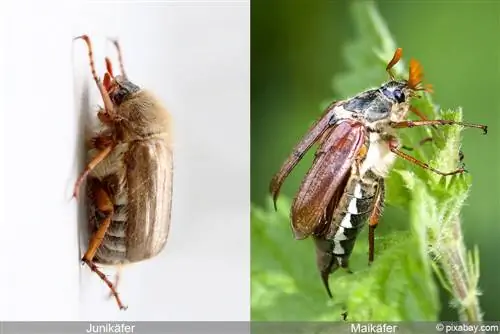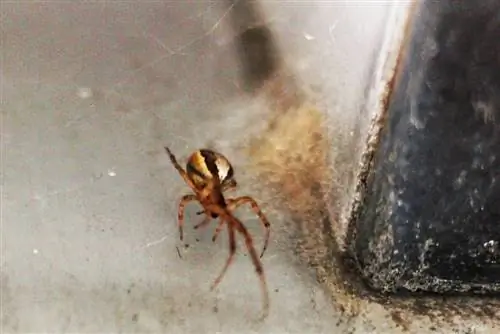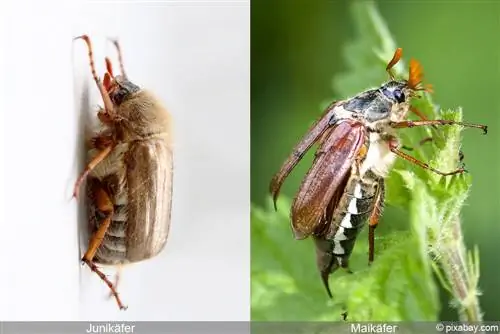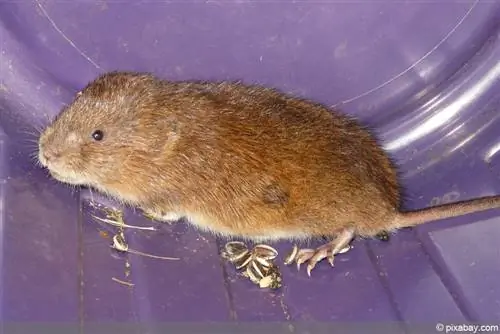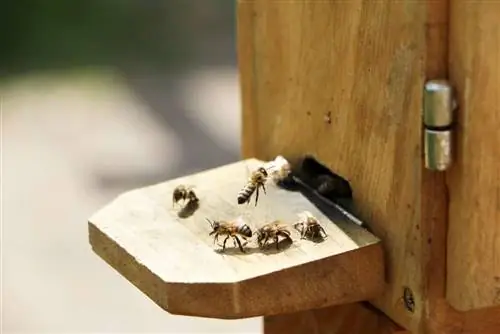- Author admin [email protected].
- Public 2023-12-17 03:39.
- Last modified 2025-01-24 12:45.
The May beetle and the June beetle are closely related, although the June beetle is only half the size. For many gardeners, only the June beetle is considered a pest because it spreads en masse and eats flowers and leaves in droves in the fall. However, the grubs, the larvae of the beetles, can also cause great damage. For this reason, both types of beetles should be combated equally in order to nip the emergence of a plague in the bud. Biological measures are always preferable to chemical means.
Cockchafer
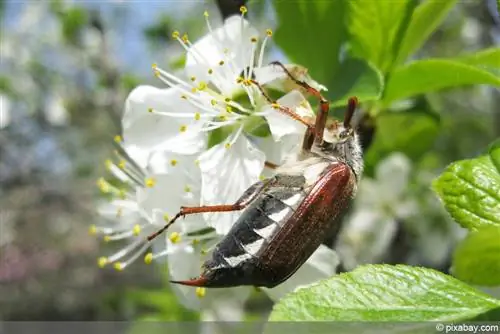
The May beetles belong to the family of scarab beetles, which take their name from the design of their antennae. The antenna slats contain up to 50,000 odor sensors, which males use to detect females that are ready to reproduce during the mating season. With the occurrence in May, trees are often bare, but these usually recover and form new leaves with the St. John's shoot in June-July. The following aspects should be taken into account when it comes to the cockchafer:
- The last segments of the antennae have broadened leaf-shaped lamellae
- The field cockchafer is the most widespread in Central Europe
- Depending on the nutritional conditions, cockchafers reach a body length of 2.5-3.0 cm
- Flies mainly in May and June, hence the name
- Feeds mostly on the leaves of deciduous trees
- Reproduction by laying eggs in the ground
- Used as chicken feed in rural areas
- May beetle infestations often occur at intervals of longer cycles
June beetle
Just like the cockchafer, the June beetle also belongs to the genus of scarab beetles, but it is only half the size of its close relative. On warm evenings at dusk, the nocturnal beetles fly more frequently through the garden and over the lawn. The June beetle feels extremely comfortable, especially in the very hot summer months with consistently high temperatures, a circumstance that leads to mass proliferation in many places.
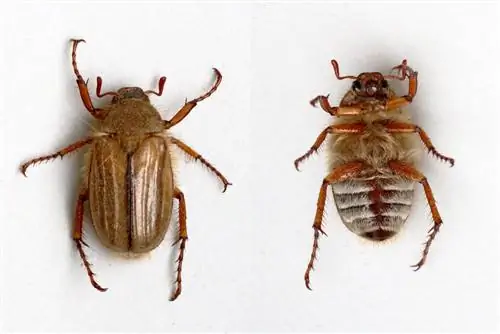
- June beetles reach a size of approx. 1.4-1.8 cm
- Yellowish to brownish body color, with slight hairiness
- Are active from June to August
- Feeds mainly on leaves and flowers
- Females prefer to lay their eggs in the grass
- Ideal conditions and temperatures lead to mass proliferation and plagues
- Fruit trees and lawns are seriously damaged by feeding, especially the roots suffer
- Lawn shows dry and yellow spots
- Fruit trees can even die completely when plagued
- Also affects rose bushes
Grubs
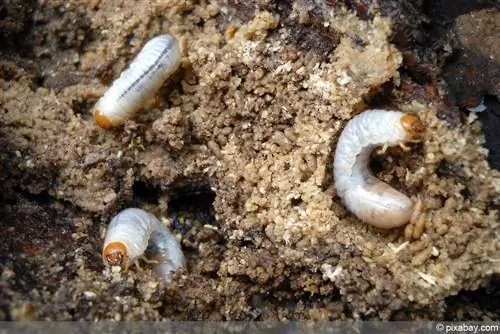
Both cockchafers and June beetles reproduce by laying eggs, from which larvae then hatch. The beetle larvae are called grubs and spend their first years of life in the ground, although the length of time depends on the species. If the site conditions are right, mass proliferation can occur, from which large swarms arise after the larval period, which degenerate into an extreme nuisance for people and animals:
- Cockchafers remain in the soil between 3-5 years
- This is followed by a complete metamorphosis into a sexually mature insect
- June beetle larvae live underground for two years
- These pupate in the spring of the third year
- Afterwards, the nocturnal June beetles hatch on warm and balmy summer nights
- Grubs have no protection from UV radiation
- Eggs and larvae require soil with high humidity
- In the cycle of 30-45 years there is an enormous spread of the larvae
Biological measures
Chemical antidotes contaminate groundwater and harm not only animals but also human he alth. Therefore, preference should always be given to biological measures in order to work in harmony with nature. In addition, the harmful poisons and chemical casting agents are often not enough to eliminate the beetles and larvae. When it comes to organic measures, the gardener is on the safe side, especially if the garden is used to grow food:
- Setting up scent traps with attractants, available from specialist retailers
- Use of parasitic fungi to be spread on the lawn in midsummer
- Fungi grow into the larvae of the June beetle and cause them to die quickly
- Fungus can survive for up to 15 years, during this period there will be no more infestation
- Milling the garden soil repeatedly from June to August
- Soil must dry well, with direct sunlight
- Eggs and larvae wither in the dry earth
Tip:
As an alternative to milling, using a pronged cultivator creates a similar effect and causes the eggs and larvae to die relatively quickly.
Nematodes
If there is a mass occurrence, the control of the beetles must be carried out more radically, but still from an ecological point of view. In this case, nematode broods are ideal:
- In extreme cases use of nematodes
- Nematodes are roundworms that attack and kill grubs
- The preparation can be purchased from specialist retailers
- Dilute powder with water and use immediately
- Use the product promptly after purchase as it has a limited shelf life
Tip:
The nematode preparation can be used to enhance the effect in wooden boards and then in the ground to attract the larvae and then cause them to die.
Prevention
Preventative measures can nip the beetle infestation in the bud and prevent the grubs from spreading in the long term. The garden remains intact and no poisons are added. These measures include, above all, covering the garden areas where the beetles tend to hang out and lay their eggs there. The beetles that are under the cover can no longer take off and mating no longer takes place:
- In summer, only water plants specifically and leave large garden areas relatively dry
- Females look for other breeding places because they prefer to lay their eggs in moist soil
- Apply plant protection nets over trees and bushes
- Cover the lawn area completely, for example with a garden fleece
- Apply covers just before dusk in the evening
- Pests can no longer penetrate the soil
- Female can no longer lay eggs in the grass soil
Natural predators
When it comes to natural control of May and June beetles, natural predators are among the best methods of combating them. These were created by nature and are completely sufficient for normal beetle reproduction:
- Specifically settle the beetles' predators
- This includes bats, cats, moles, shrews and birds
- Giving useful animals a new habitat
- Provide nesting opportunities for birds
- Hang up bat boxes
- Put out cat food and water bowls
Conclusion
Both the May beetle and the June beetle can become a real pest in the garden if they encounter suitable conditions for feeding and reproduction. Since the larvae remain in the ground as grubs for many years until they hatch, many gardeners are unaware of the impending danger for a long time. The nasty surprise comes after hatching when the young beetles attack the trees and bushes in the garden and leave the lawn withered and brownish in color. Biological measures are a great help in combating beetles, including scent traps, parasitic fungi and milling and cultivating the lawn. If extreme cases arise, spreading nematode brood, special roundworms that kill the beetle, helps. As a preventive measure, the lawn, trees and plants can be covered at dusk so that the beetles no longer have access. Natural predators are the best method of combating these annoying insects; they ensure that the spread is constantly contained.

